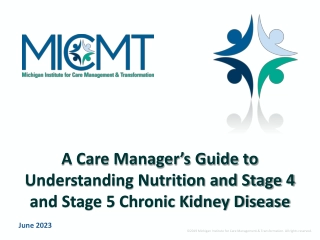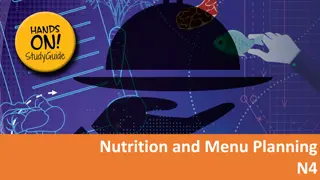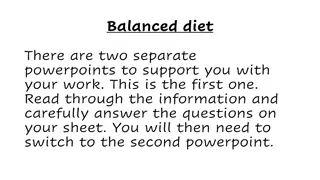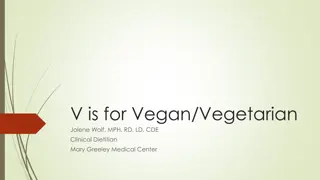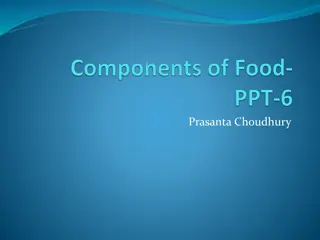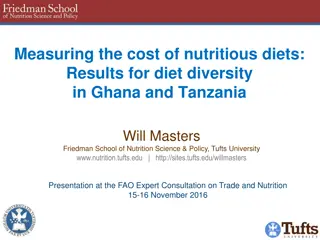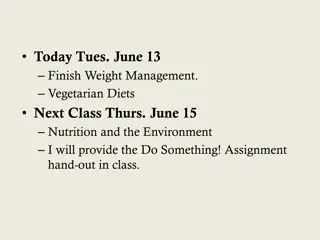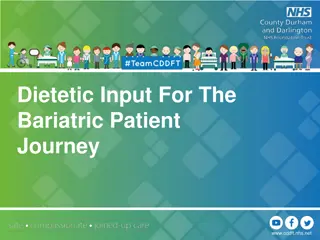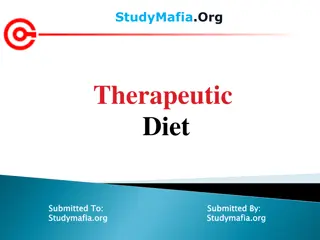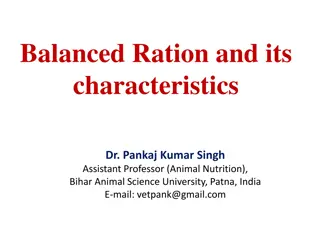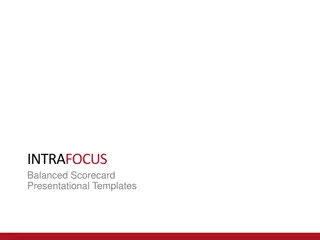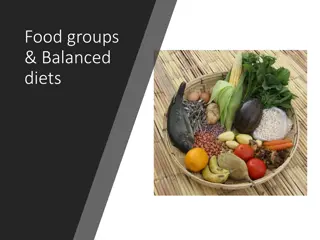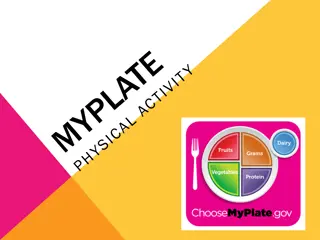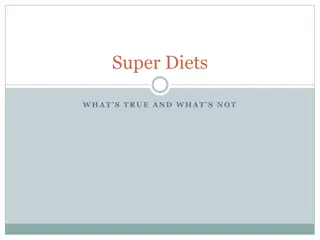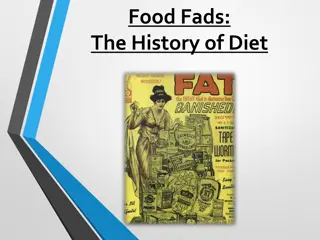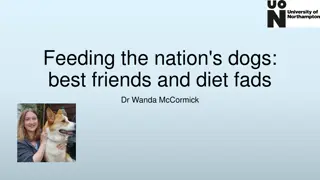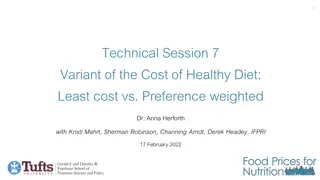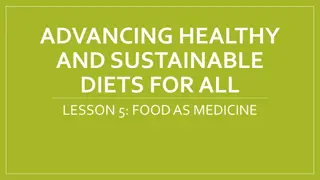Guide to Planning Balanced Diets for All Age Groups
Learn about the importance of balanced diets, nutritional needs for different age groups, and how to plan balanced menus using the food pyramid. Discover tips for weaning babies onto solid foods, including the introduction of iron-rich cereals and vitamin C sources. Ensure babies' diets are free from added sugar, salt, and unnecessary ingredients, and promote healthy eating habits from an early age.
Uploaded on Sep 09, 2024 | 0 Views
Download Presentation

Please find below an Image/Link to download the presentation.
The content on the website is provided AS IS for your information and personal use only. It may not be sold, licensed, or shared on other websites without obtaining consent from the author. Download presentation by click this link. If you encounter any issues during the download, it is possible that the publisher has removed the file from their server.
E N D
Presentation Transcript
Chapter 05: Balanced Eating Planning Balanced Diets
What I Will Learn To use the food pyramid and healthy eating guidelines to plan balanced diets To describe the nutritional needs and dietary requirements of each age group To plan balanced menus for all age groups
Key Words Weaning Sedentary Manual Convalescent Invalid
A Well-Balanced Diet A well-balanced diet: Contains all the nutrients in the correct proportions for each individual. Is achieved by eating a wide variety of foods chosen from all the food groups in the food pyramid. Meets the dietary requirements of the lifestage of the individual. Don t forget! We should aim to include three out of the four main food groups in each meal for all individuals.
Babies Babies should be breastfed if possible for the first few months of life (why?) If dried formula milk is used, follow the measuring and preparation instructions carefully. (why?) Milk remains an important part of a baby s diet, but solid foods can be introduced at around 4 6 months. This is called weaning.
Babies (continued) All solids must be mashed up or liquidised at first, so the baby learns to swallow. Each new food should be introduced one at a time so that the baby will get used to a variety of tastes and food intolerances can be recognised. Babies are usually born with sufficient iron to last them six months. It is recommended that their first solids include cereals with a bland flavour that is similar to milk but that also contains iron, e.g. ground rice or semolina.
Babies (continued) Babies need vitamin C. Serve fruit juices in a cup or on a spoon never in a bottle as this will rot their teeth. Sieved/pur ed fruit and vegetables also provide vitamin C. Avoid using too many convenience baby foods. (why?) Do not add sugar or salt to baby foods as they are unnecessary in the diet. Exclude tea, coffee, fatty, fried or spicy foods and honey from the diet of babies under one year.
Babies (continued) Crunchy foods such as rusks and apples help to soothe teething problems and strengthen gums. By the time the baby is one year old they should be eating many of the same foods as the rest of the family.
Case Study: Babies Ann has a four-month-old baby who has been breastfed but now needs to start weaning. 1. Offer Ann some tips and advice on weaning. 2. Suggest some suitable weaning foods.
Children Childhood is a very important time in terms of growth and development. It is at this stage that eating habits are established. The diet of children should be highly nutritious and balanced.
Children (continued) Children should be encouraged to eat a wide variety of healthy foods based on the food pyramid. Meals should be based on regular family meals, to encourage healthy eating patterns and provide good parental example. Portions should be small and attractively served experts recommend three small meals and two to three healthy snacks per day. Avoid using desserts, chocolate or sweets as treats or rewards and discourage faddy (fussy) eating.
Children (continued) Important nutrients for children include: Protein for growth Carbohydrates for energy and some fibre Calcium, vitamins A and D for healthy teeth and bones Iron to prevent anaemia Children should be given full-fat milk and other dairy products until they are at least two years old to make sure they get enough vitamins A and D. Fruit and vegetables are important to supply vitamins, minerals and fibre. They add bulk to the diet but are low in fat.
Children (continued) Encourage children to drink water rather than fruit juices and fizzy drinks to prevent dehydration. Sweet treats and snack foods high in salt and fat should be limited and only eaten after meals to reduce the risk of childhood obesity. A healthy breakfast, including foods from three of the four main food groups, is important for children.
Case Study: Children Melissa is an eight-year-old in Third Class in primary school. She eats very little vegetables and fruits. Her mother is worried that her diet is lacking in nutrients. 1. Give her mother some tips and advice on nutrition for children. 2. Suggest some interesting ways that Melissa s mother could introduce fruits and vegetables into Melissa s diet.
Teenagers Protein foods are needed for growth and hormone development in teenagers. Active teenagers can include a lot of high-energy foods in their diet. (Can you name some of these foods?) However, inactive teenagers will become overweight on a high-energy diet. (What should they do to avoid becoming overweight?)
Teenagers (continued) High-fibre energy foods, e.g. cereals (preferably wholegrain), should be chosen, as they prevent bowel disorders and constipation. Teenagers should avoid eating too much junk food or snacks that are high in sugar but supply few other nutrients. Fried foods or high-fat foods should be kept to a minimum as they can cause weight problems and tend to aggravate acne and other skin problems. Drinks, particularly water, help keep the skin clear. Fruit and vegetables supply fibre and vitamin C, which also help to keep the skin in good condition.
Teenagers (continued) Calcium and vitamins A and D are important for the development of healthy bones and teeth and help to prevent osteoporosis in later life. Iron and vitamin C are particularly important in the diet of teenage girls (because of menstruation) to prevent the development of anaemia. Teenagers who wish to follow a vegetarian or vegan diet must be careful to eat a balanced, nutritious diet. Busy schedules, exam stress, worry over physical appearance and peer pressure can all affect a teenager s food choices.
Case Study: Teenagers Shane is a fifteen-year-old student doing his Junior Cycle this year. He plays Gaelic football for his local GAA club. He wants a live a healthier lifestyle to improve his concentration and physical fitness. 1. What dietary advice can you offer him? 2. Suggest some foods he should include in his diet. 3. Plan a day s menu for him and include some snacks for before and after training.
Adults All adults should eat a well-balanced diet that includes a variety of foods. Energy intake varies according to the gender, body size and activity level of the individual. Balance energy intake with activity. As people age (over 25), their calorie requirements reduce unless they are very active.
Adults (continued) Sedentaryworkers Adults who are not very active need to reduce their kilocalorie intake to prevent weigh gain. Alcohol and foods that are high in fat and sugar should be restricted. Exercise helps to control weight.
Adults (continued) Manual workers These lead a more active lifestyle so they can afford to eat a higher-energy diet, but it is advisable to choose energy foods that are also high in fibre and restrict those that are high in sugar or fat.
Adults (continued) A good supply of protein is essential to repair body cells and maintain good health. Include a good mix of animal and vegetable proteins. A plentiful supply of vitamin B ensures the release of energy from food. Keep fat intake low reduce animal fat and replace it with low-fat dairy products or vegetable oils to help reduce cholesterol and supply omega fatty acids. Salt intake should be reduced because salt is associated with high blood pressure.
Adults (continued) Carbohydrate foods are needed for energy; the diet should be high in starches and fibre and low in sugars to reduce the risk of obesity and diabetes. A high fibre diet is recommended to aid digestion and avoid constipation. It is important that women in particular eat enough calcium-rich foods in order to reduce the risk of bone disease. Iron is also of importance to women to avoid becoming anaemic. Vitamin C is also needed to help absorb the iron. Keep alcohol intake to a minimum as it is a source of empty kilocalories.
Case Study: Adults John is a fifty-year-old builder who has put on a lot of weight recently. His regular diet includes a fry for breakfast and a takeaway in the evening. His doctor has advised him to cut down on foods high in saturated fats. 1. What dietary advice can you offer John? 2. Suggest some foods he should include in his diet. 3. Plan a day s menu for him and include a packed lunch.
Pregnant and Breastfeeding Women During pregnancy, the baby depends on the mother for its nutrients and health. A failure to follow a healthy diet may cause deficiency diseases in mother and baby. While it is not necessary to eat for two , it is important to eat a well- balanced nutritious diet.
Pregnant and Breastfeeding Women (continued) Energy intake should be increased slightly but a pregnant woman should avoid excessive weight gain. Protein is very important for the growth of the foetus. Calcium, phosphorous and vitamins A and D are essential for healthy bone and teeth development in the baby and to reduce the risk of bone disease in the mother. Fruit, vegetables and wholemeal cereals supply fibre and vitamins B and C.
Pregnant and Breastfeeding Women (continued) Intake of fluids, such as water and low-sugar fruit juices, should be increased to prevent constipation Iron is necessary to prevent anaemia and may need to be supplemented by iron tablets. Folic acid should be taken to reduce the risk of neural tube defects in newborn babies.
Pregnant and Breastfeeding Women (continued) Pregnant women should avoid: Strong tea and coffee Rich, spicy or fatty foods Soft cheeses, p t , cook-chill foods and prepared salads because of the risk of listeria Soft cooked or raw eggs, e.g. mayonnaise, because of the risk of salmonella Liver and shellfish Alcohol, smoking and drugs of any type, unless prescribed
Case Study: Pregnant Woman Vanessa is a thirty-two-year-old pregnant woman who wants to eat a well-balanced, nutritious diet during her pregnancy. You are the nurse in the clinic who advises pregnant mothers on their diet. 1. Compile a set of simple guidelines that you can hand out to Vanessa and other expectant mothers.
OlderPeople Older people may have problems that affect their diets. They may: Live on low incomes Experience a loss of appetite or interest in food or have poor digestion. This may result in a poor diet, e.g. buying less variety of fresh foods and more convenience foods, which can lead to malnutrition.
Older People (continued) They may: Have poor general health or physical disabilities such as arthritis, poor mobility, weak eyesight and dental problems, which could interfere with shopping for, preparing, cooking and eating food Have reduced mental capacity which could affect an older person s ability to ensure a healthy diet. Loneliness can also lead to a lack of interest in cooking for one person Have difficulties when shopping, e.g. they are less mobile, live to far from the shops, or are unable to carry heavy shopping bags
Older People (continued) Older people should eat three balanced meals every day. This can be difficult as many have small appetites. They should follow the healthy eating guidelines and eat less sugar, salt and fat, more fibre and drink plenty of water. A supply of protein is important to help replace worn-out body cells and to maintain good health so choose easy-to- digest proteins like white fish and chicken. As many older people are less active, they should reduce their intake of high-energy foods to prevent excess weight gain. Low-fat alternatives will also help.
Older People (continued) High-fibre foods and plenty of fluids are necessary to aid digestion and prevent constipation. Dairy foods are essential for calcium and vitamins A and D. These nutrients help to keep bones and teeth healthy and to prevent osteoporosis. Meat, including offal, is a good source of iron, which helps to prevent anaemia. Vitamin C found mainly in fruit and vegetables helps iron absorption and protects against colds, flu and other infections. Spicy foods can be hard to digest.
Older People: Preventing Malnutrition Buy specialised kitchen gadgets, e.g. tap-turners, jar openers and electrical can openers. Use services such as Meals on Wheels and Home Help. Use supermarket home delivery services. Have emergency supplies always in store, e.g. dried and tinned foods.
Case Study: Older People Martin is an active seventy-five-year-old who has recently been widowed. He lives alone and has to cook for himself. He relies on fried foods and takeaways. The public health nurse has advised him that his current diet is bad for his heart and he must to cut down on foods high in saturated fats. 1. What dietary advice can you offer Martin? 2. Suggest some foods he should include in his diet. 3. Plan a day s menu for him and include a simple lunch.
Invalids and Convalescents Invalids and convalescents need a nourishing diet to help restore them to good health. They may have a very poor appetite at first, so it is essential that the foods they eat contain the important nutrients without being too bulky. Invalid: A person who has been affected by a disease or medical disorder over a long period. Convalescent: A person who is recovering from an illness.
Invalids and Convalescents (continued) Follow doctor s orders. Choose foods that are easy to digest and lightly seasoned; avoid spicy, fatty foods and coffee. Serve small attractive portions that are easy to eat, and remove any leftovers when the meal is finished. Boil, steam, stew or grill instead of frying or roasting. Meals should be prepared under strict hygienic conditions. Use good-quality fresh foods avoid using leftovers or reheated foods.
Invalids and Convalescents (continued) Eat protein-rich foods to repair and replace body cells lost during the illness. Energy intake should be reduced during convalescence as energy expenditure is low. Fibre is important to prevent constipation, which is more likely due to inactivity. Vitamins, especially vitamin C, help the body to return to health and build up resistance to further infection.
Invalids and Convalescents (continued) Minerals, especially iron, are important if there has been any blood loss to prevent the patient from becoming run down or anaemic. Fluids are always important in the diet but are particularly important if the person has a fever or high temperature. Water helps to replace the fluids lost through perspiration and prevents the body from becoming dehydrated. This is a condition that can be especially dangerous in the case of babies or very young children.


